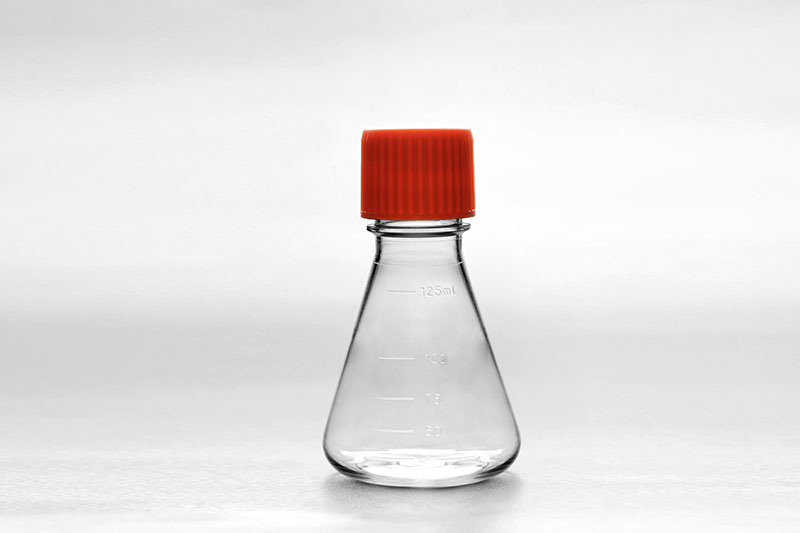วัสดุและวิธีการ
3.1. Shake Flask Cultivations
Pre-cultures ของเซลล์แขวนลอย MDCK.SUS2 ถูกปลูกใน shaker flasks (ขวด Erlenmeyer โพลีคาร์บอเนต 125 มล., #431143, Corning®, New York city, NY, USA) ด้วยปริมาตรการทำงาน 50 มล. (wv) ในตู้ฟักไข่ Multitron Pro (Infors HT, Bottmingen, Switzerland) ที่อุณหภูมิ 37 °C และบรรยากาศ CO2 5% ด้วยความถี่การเขย่า 180 รอบต่อนาที เซลล์ถูกส่งผ่านทุก 3-4 วันด้วยความหนาแน่นของการเพาะ 0.5–0.8 × 106 cells/mL.
IAV A/Puerto Rico/8/34 (H1N1) seed virus ใช้สำหรับการติดเชื้อ ในเซลล์ MDCK ที่ยึดติด (ECACC # 84121903) ไวรัสเมล็ดพันธุ์มีไทเทอร์ 1.1 × 109 TCID50/mL.
Cells ได้รับการปลูกฝังในอาหารที่กำหนดทางเคมี ปราศจากโปรตีน และปราศจากส่วนประกอบของสัตว์ Smif8 (Smif8 PGD 2×, เสริมด้วยกลูตามีน 5 mM และ 8 mM ไพรูเวต) ที่พัฒนาขึ้นโดยเฉพาะสำหรับการเพาะเลี้ยงเซลล์ MDCK ของสารแขวนลอย [95].
การเติบโตและการทดลองการติดเชื้อสำหรับการตรวจสอบความถูกต้องของแบบจำลองได้ดำเนินการโดยใช้ขวดเขย่าขนาด 500 มล. (#4113-0500, Nalgene™, Thermo Scientific, Waltham, MA, สหรัฐอเมริกา) ด้วยปริมาตรการเพาะปลูกเริ่มต้น 200 มล. ที่ 150 รอบต่อนาที ทำการเพาะปลูกสองครั้ง การติดเชื้อจำลองหนึ่งครั้ง (การเพาะปลูก 1) โดยที่เซลล์เติบโตประมาณ 200 ชั่วโมง และการติดเชื้อหนึ่งครั้ง (การเพาะปลูก 2) โดยที่เซลล์ติดเชื้อ IAV ในเวลาประมาณ 49 ชั่วโมงหลังการฉีดวัคซีน เพื่อให้บรรลุการติดเชื้อแบบซิงโครนัสของประชากรเซลล์ ใช้ moi = 10 เนื่องจากความเข้มข้นของเซลล์ค่อนข้างต่ำในช่วงเวลาของการติดเชื้อ (2.1 × 106 เซลล์/มล.) และใช้ moi สูง จึงไม่จำเป็นต้องมีการเปลี่ยนสื่อหรือเติมทริปซิน (สำหรับการกระตุ้นไวรัส) ในการเพาะปลูกทั้งสองแบบ มีการเติมน้ำ Milli-Q ที่ปราศจากเชื้อก่อนการสุ่มตัวอย่างเพื่อชดเชยการระเหยของน้ำ (1-2 มล./วัน) เนื่องจากทำการทดลองในตู้ฟักที่ไม่ได้ให้น้ำ
ที่มาจาก: https:/ /www.mdpi.com/2218-1989/12/3/239/htm
The FAI climbed 5.9 percent year-on-year in the first 11 months of 2018, quickening from the 5.7-percent growth in Jan-Oct, the National Bureau of Statistics (NBS) said Friday in an online statement.
The key indicator of investment, dubbed a major growth driver, hit the bottom in August and has since started to rebound steadily.
In the face of emerging economic challenges home and abroad, China has stepped up efforts to stabilize investment, in particular rolling out measures to motivate private investors and channel funds into infrastructure.
Friday's data showed private investment, accounting for more than 60 percent of the total FAI, expanded by a brisk 8.7 percent.
NBS spokesperson Mao Shengyong said funds into weak economic links registered rapid increases as investment in environmental protection and agriculture jumped 42 percent and 12.5 percent respectively, much faster than the average.
In breakdown, investment in high-tech and equipment manufacturing remained vigorous with 16.1-percent and 11.6-percent increases respectively in the first 11 months. Infrastructure investment gained 3.7 percent, staying flat. Investment in property development rose 9.7 percent, also unchanged.
 English
English



















































